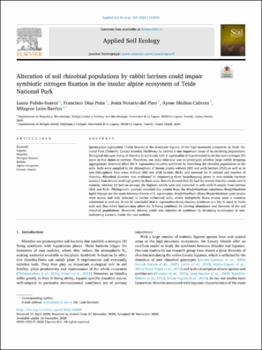Alteration of soil rhizobial populations by rabbit latrines could impair symbiotic nitrogen fixation in the insular alpine ecosystem of Teide National Park.
Fecha
2021Resumen
Spartocytisus supranubius (Teide broom) is the dominant legume of the high-mountain ecosystem in Teide National Park (Tenerife, Canary Islands). Herbivory by rabbits is one important cause of its declining populations.
Biological nitrogen-fixing of rhizobia in symbiosis with S. supranubius is hypothesized to be the main nitrogen (N) input in this alpine ecosystem. Therefore, our main objective was to investigate whether large rabbit dropping
aggregations (latrines) affect the S. supranubius-rhizobia symbiosis by disturbing the rhizobia populations in the soils. Soils were sampled in the rhizosphere of broom plants without (RS) and with latrines (RLS) as well as in non-rhizospheric bare areas without (BS) and with latrines (BLS), and assessed for N content and number of rhizobia. Rhizobial diversity was evaluated by sequencing three housekeeping genes in root-nodule bacteria isolated from broom seedlings grown in these soils. Results showed that BS had the lowest rhizobia counts and N content, whereas RS had on average the highest, which were not exceeded in soils with N-supply from latrines (BLS and RLS). Phylogenetic analysis revealed that strains from the Bradyrhizobium canariense/Bradyrhizobium
lupini lineage are the main microsymbionts of S. supranubius. Bradyrhizobium rifense/Bradyrhizobium cytisi strains were scarce and only detected in latrine influenced soils, where endophytic Bosea strains seem a common cohabitant in nodules. It can be concluded that S. supranubius-Bradyrhizobia symbiosis is a key N input in Teide soils and that rabbit latrines may affect the N-fixing symbiosis by altering abundance and diversity of the soil
rhizobial populations. Moreover, latrines could also interfere in symbiosis by favouring co-entrance of nonnodulating bacteria inside the root nodules.






